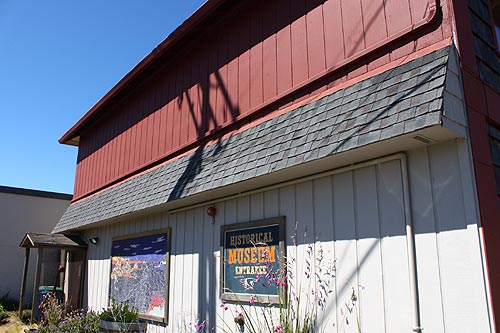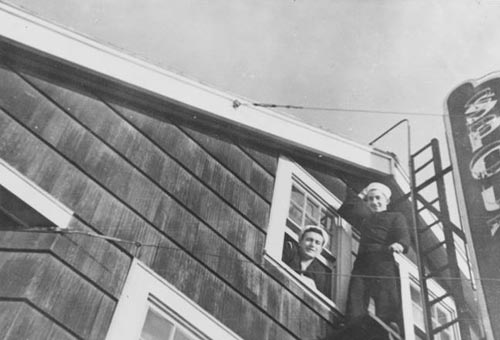Remnants of WWII on Oregon Coast You Can Visit
Updated Periodically
By Oregon Coast Beach Connection staff

(Oregon Coast) - Some are quite obvious and out in the open, with Battery Russel and the blimp hangar at Tillamook being the most recognizable and easily found leftovers of World War II on the Oregon coast. Other examples of how this state helped with the Last Great War get less and less obvious, until some become downright legends or even mysteries. Still others are hiding in plain sight. (Above: the stone shelter at Cape Perpetua).
Ever wondered what remnants of World War 2 still exist along the Oregon coast? What artifacts you could look at? What structures still stand? There are quite a few, actually – even more if you count the objects and documentation you can discover in some of the local history museums.
Here, however, is a guide to many of the places and things you can visit that have a World War 2 story behind them.

In Warrenton there's Battery Russell, at what is now Fort Stevens State Park, which was the big watch dog of the Columbia River during wartime, going all the way back to the Civil War. But it's more famous for one of the few chunks of U.S. ground fired upon by a foreign power in about 200 years (until 9/11). Just before midnight on June 21, 1942, a Japanese submarine lobbed shells towards the fort, making a few craters in the beaches nearby.
The fort did not fire back lest it give away its location to the enemy. In later years, that Japanese sub commander admitted he had no idea what he was firing at. There is a plaque onsite regarding the event, which included a dedication by vets from Fort Stevens and the attacking sub.

The nearby Wreck of the Peter Iredale was used in a tiny way in the war effort. Much of Oregon's beaches were covered in barbed wire during the war, and the Iredale actually had some of the wire wrapped around it.
The village of Cape Meares (on the north face of the headland of the same name) had a disturbing visit from a Japanese sea mine in 1953. A young man found it lying on the beach one day that winter, and locals had set up a quarantine around it to keep people away as they waited for officials. One night, the ocean got to it and started causing it to rock back and forth.
The object exploded suddenly, just minutes after a young man went down to check on it with a flashlight. There was only a small bank of sand that protected him from the blast, and the explosion was heard miles away.
In Oceanside, there was a radar station. You can still find Radar Road where it was, a couple miles north of town. It is rumored a cannon was placed at the secret beach just behind Maxwell Point, to stand guard against any invaders. It's unclear if this is true, however.
 In August of 1943, a B-17 Flying Fortress bomber crashed into Cape Lookout, killing nine men. The craft was on a training run out of Pendleton and hit foggy weather, somehow managing to fly too low by 50 feet, slamming into the headland at 200 mph.
In August of 1943, a B-17 Flying Fortress bomber crashed into Cape Lookout, killing nine men. The craft was on a training run out of Pendleton and hit foggy weather, somehow managing to fly too low by 50 feet, slamming into the headland at 200 mph.
There is a plaque now along that trail that memorializes the crash and lists the 10-man crew by name. For a few decades, scavengers did manage to take some objects from the wreck, but the site is hidden now and too dangerous to approach.

Lincoln City has a very real leftover from the war in the North Lincoln County Historical Museum (photo above). There, you'll find a Japanese mine on display. It is a type 93 mine from the Imperial Japanese Navy. Several of these were found along the Washington and Oregon coasts. Where was this one found? You'll have to visit the museum to find out. 4907 SW Highway 101. Lincoln City, Oregon. 541-996-6698. http://www.northlincolncountyhistoricalmuseum.org/

The famed Spouting Horn restaurant in Depoe Bay was briefly used as a U.S. Coast Guard headquarters during the war years, as they assisted in patrolling the Oregon coast for any enemies.
In Newport, the concrete barge S.S. Paisley, left over from World War 2, was sunk in Yaquina Bay in the 50's to provide solid ground for a log shipping terminal. That chunk of debris started creating an environmental hazard in the 90's and was removed.
When you look at the airports of Astoria, Newport, North Bend and Tillamook, you're looking at airfields originally constructed during World War II for defense purposes.
Unknown History: Two Ships That Were Torpedoed by Japanese Off South Oregon Coast: One fascinating chunk of coastal history that's not well known is that U.S. vessels were hit by torpedoes from a Japanese submarine off the areas around Gold Beach and Coos Bay. In fact, it was the same sub that fired on Fort Stevens.
This sprawling tale in the link above even reaches into the Washington coast.
 The most famous and most obvious remnant of wartime creations were the blimp hangars at the Tillamook Air Museum. There were originally two, but one burned in the 90's. These housed the patrol blimps that cruised over the coastline in search of possible enemy intrusions. The remaining hangar is over 1,000 long and over 100 feet high. You can see other artifacts of World War 2 flight here as well. 6030 Hangar Rd, Tillamook, Oregon. (503) 842-1130. http://www.tillamookair.com/
The most famous and most obvious remnant of wartime creations were the blimp hangars at the Tillamook Air Museum. There were originally two, but one burned in the 90's. These housed the patrol blimps that cruised over the coastline in search of possible enemy intrusions. The remaining hangar is over 1,000 long and over 100 feet high. You can see other artifacts of World War 2 flight here as well. 6030 Hangar Rd, Tillamook, Oregon. (503) 842-1130. http://www.tillamookair.com/
A big favorite on the Oregon coast is the stone shelter at the top of Cape Perpetua, near Yachats. But it had a much more somber purpose during WWII. It served as a lookout station, with troops and citizens scanning the ocean for any incoming bad guys.
See more: Oregon Coast During World War II, History Still Haunts These Shores
Oregon Coast Lodgings for this - Where to eat - Maps and Virtual Tours

More About Oregon Coast hotels, lodging.....
More About Oregon Coast Restaurants, Dining.....
LATEST Related Oregon Coast Articles
Likely just before dawn best hour but peak happens during daylight. Weather
Dark Sky Week is Prime Along Oregon Coast: Where and Where Not to Go
General guide to dark sky viewing from south to north coast. Astronomy
Sizable Price Drop, Deals in Lincoln City During Quiet of April on Central Or...
20 perc off at A1 Vacation Rentals across its roster, including Gleneden Beach. Lincoln City specials
Upcoming S. Oregon Coast Events Include Gem Show, History: Coos Bay, Bandon
May 6 talk at Coos History Museum, Mayfly Fest May 17, Bandon Rock / Gem Show June 7,8
Washington Coast Cleanup on April 19 - Coinciding with Oregon Coast's SOLVE E...
From the Puget Sound to Long Beach, alongside Oregon's cleanup. Washington coast events, Seaside events
Astoria's Riverwalk Gets New Lighting, More N. Oregon Coast Roadwork
Delays coming this summer, but the riverwalk has a new look. Seaside, Cannn Beach
April Gets Even Cheaper Midweek at Depoe Bay, Lincoln City: Oregon Coast Deals
Off-season rates plus more at Keystone Vacation Rentals. Depoe Bay lodging specials, Lincoln City hotel reviews, Newport hotel reviews
Washington Coast Begins Week of Clam Digs, April 12 Through 18
Long Beach, Twin Harbors, Mocrocks and Copalis at different times. Washington coast events
Back to Oregon Coast
Contact Advertise on BeachConnection.net
All Content, unless otherwise attributed, copyright BeachConnection.net Unauthorized use or publication is not permitted








































